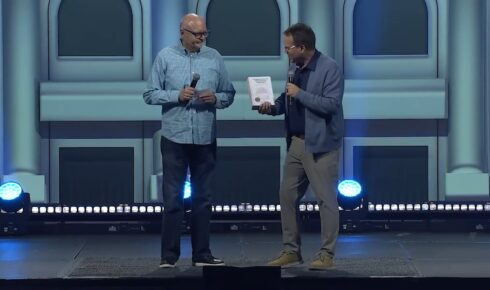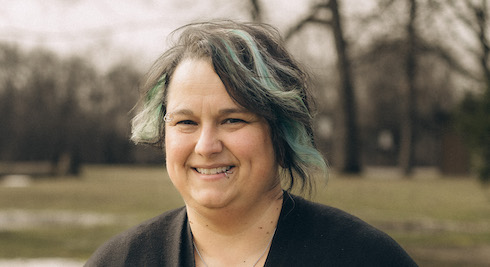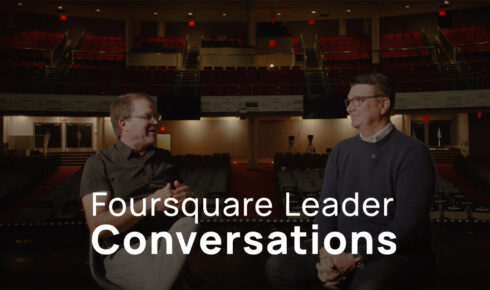Life has come full-circle in a profound way for Michael Lienau, a filmmaker who lives on Camano Island, Wash., about an hour north of Seattle.
At the age of 9, he was intrigued with his mother’s 8-millimeter camera and asked her if he could use it to make movies. She told him to ask Jesus if that was what He wanted him to do. Michael did—and little did he know that making simple home movies would blossom into something big.
 When he was 13, an NBC affiliate found out about Michael’s talent and asked him to shoot news for them in Klamath Falls, Ore., where the fledgling filmmaker was raised. His first assignment would forever change his life.
When he was 13, an NBC affiliate found out about Michael’s talent and asked him to shoot news for them in Klamath Falls, Ore., where the fledgling filmmaker was raised. His first assignment would forever change his life.
“The U.S. government started buying out all of the Native American tribes, and they tried two test tribes,” he recalls. “One was in my hometown. A Native American man refused to sell his land, and he became the focus of our story. When I went out to film him, God endeared our hearts together.”
Michael followed the story for five years. Ultimately, President Jimmy Carter signed the bill that enabled this man to keep his land. Michael finished the documentary about this story when he was 18, and it aired on PBS.
In January 1977, Michael saw the Roots TV series, which was based on Alex Haley’s best-selling novel about his African ancestors.
“Here was real-life drama exposing the dark side of our country. It raised some significant questions,” Michael recalls. “I said, ‘I want to make films like this some day.'”
Michael came to grips with his salvation a few years later. In May 1980, he made a risky decision to do some filming on Mount St. Helens after it erupted. A second eruption that occurred while he was on the mountain led to a three-day struggle to survive. He wasn’t sure if he would make it out alive—and if he didn’t, he wasn’t sure where he would spend eternity.
“That’s really when I said, ‘Lord, I’m yours. I got myself in this mess, and I really need you to get me out,’ ” he explains.
God spared his life and continued to give him a passion for racially sensitive issues. In 1983, he worked on two biographical documentaries about Alex Haley for Japanese television. When Michael visited him in Arkansas, Haley shared that it was his dream to one day see healing and reconciliation. It was a conversation Michael never forgot.
In the early 1990s, Michael read Healing America’s Wounds by John Dawson—and it put all the pieces together for him. It also gave him a passion to make a difference. Dawson’s book helped Michael realize that he wanted to help bring healing by providing biblically based answers.
Putting Faith Into Action
Michael’s professional goals intersected with his personal life in 2002. At that time, the Lord gave his wife, Shari (whom he had hired as an intern and married a year later), a burden for orphans. The Lienaus already had four children; but when Shari received a phone call about five Native American/Hispanic siblings who were going to be available for adoption, she just “knew” they would soon be part of their family.
Michael, however, wasn’t so sure. “One of my spiritual gifts is faith—and I have faith for a lot of things-but this was not one of them,” he recalls. “This was really shaking my world because of the logistics of having a house or vehicle big enough for nine children. Mainly, the biggest obstacle was, it was going to change my life, goals and dreams. It was not in my life’s plan.”
As it turned out, Kleos Children’s Community—the center housing the five siblings—asked Michael to produce a promotional video for the organization. Located in southern Oregon, the center is run by retired Foursquare pastor Gordon Hankins and his wife, Vicki.
“Michael took some of our biological kids [with him to the center], and it was there where the Lord really worked on his heart,” Shari notes.
The Holy Spirit also began preparing their children’s hearts for additional family members. “Their hearts were broken for the fatherless,” Shari continues. At one point during a family worship time, their oldest son, Jacob, prayed: “God, how could it not be that we adopt these kids? Please let it be.”
“God had to hit me over the head with a 2×4 to understand that I can’t just make these kinds of films and go around talking about racial reconciliation,” Michael acknowledges. “I actually had to do something about it. God was presenting me with an opportunity to help me really live this out. It was a total God setup.”
Michael had produced a video series in 1992 based on Dawson’s Healing America’s Wounds. Through this project, he and his family had met dozens of Native Americans and spent time on reservations and revival camps.
He also was familiar with the five siblings’ stories and their tribe as a result of the project he had done for the foster home. Typically, tribal law prohibits adoption; but because these children had two ethnicities, they were not required to stay within the tribe and were available for adoption.
On Thanksgiving Day 2002, the Lienau family visited the five siblings at their foster home. The family presented a video that introduced their home and pets and gave the children more details about their family. At the end of the video, they told the children they were dreaming of them becoming part of their family. The siblings were ecstatic. Indeed, it was a day of celebration for everyone involved.
The next day, the Lienaus picked up the children to take them home. “I’ll never forget that day,” Michael recalls. “I heard this little voice saying, ‘Dad … Dad … Dad.’ It was Joseph. It was his dream to someday have a real father. He and his brother and sisters had been waiting for two years to have a forever family.”
As an added bonus, John Dawson, who had scheduled a video shoot months in advance, was in town the day the Lienaus’ newly adopted children came home. He dedicated them and was part of their homecoming celebration.
In addition to Joseph, the adopted children are Bibianna; Tatianna; Corina; and Joshua. Jacob’s biological sisters are Anna; Janey; and Esther.
Keeping It Real
When the Lienaus relocated to their 14-acre Camano Island property in 1995, they felt God was leading them to move from a congested Seattle neighborhood; but they wondered why they would need so much land.
“Now we understand,” Michael says. “My studio is here. We have places for horses and cows, chickens and all the things you do when you homeschool. The kids love it here and feel really safe.”
Despite the bountiful land, their home was a modest 2,000 square feet before they adopted. The Sunday they announced their adoption plans to their church family at Stanwood Foursquare Church in Stanwood, Wash., one member stood up and said, “They are going to need more bedrooms.” Church members, friends and family donated materials, time and labor to turn their garage into two bedrooms, a bathroom and a laundry room.
Initially, Michael wondered how he would provide for his family. Now, however, he doesn’t worry about finances. The Lord has provided one miracle after another, and he and Shari have learned more than ever before to trust God for His provision.
Church members stepped up to the plate in practical ways. For the first two years after the Lienaus adopted the children, several church families brought them dinner once a week and watched the children so that Michael and Shari could go out for a date night.
“There were some days when I was so wiped out I didn’t think I could even go,” Shari remarks, “but this has proved to be one of the best investments of our time.”
John Fehlen, then the pastor of Stanwood Foursquare Church, notes that the Lienaus inspired the congregation with their “passion for adoption, racial reconciliation, community transformation, repentance and unity.”
“Michael and Shari put their faith into action,” he says. “They live out the Word.” Fehlen notes the Lienaus inspired him and his wife to consider adopting.
Some grafted fruit trees in front of their home helped Michael and Shari explain adoption to their new children.
“We showed them what the old tree was and explained that someone took a branch from another tree and put it into this tree here, and it grew into a new tree,” Michael explains. “We use this visual to show them what our new family is.”
From the start, the Lienaus knew that blending two families wouldn’t be easy. In fact, their family motto is the battle cry of Lakota Sioux Indian warriors before they went to war: Hoka Hey! (It’s a good day to die!)
The key to raising children, especially nine, is prayer. Says Shari: “As I relish in His love for me, I get filled up and have what I need to give. When I don’t, I don’t have much to give. My flesh, my energy, wears out pretty quickly.”
Michael and Shari have let their children know that there are different privileges for different kids at different times.
“We encourage them not to compare, because if we try to make everything even—whether it’s privileges, time spent, possessions, etc., we get into trouble,” Shari says. “The Lord has been so faithful to tell me, ‘You need to fill this love tank a little bit more.’ Or, ‘The reason this person is acting out is because they are just feeling a little squeezed out.'”
The household joke, Shari says, is that she is always making new schedules. “We follow them for a while, and they provide a guide. Routine is important for being at home and controlling what would be chaos, but we try not to be too rigid.”
On a typical day, designated children are in charge of getting breakfast, doing laundry and feeding the animals. The family usually has a time of worship or Bible reading before or after breakfast. Then the children have a few hours of school time.
After lunch, they do chores and have quiet time. The older children are involved in Michael’s business, Global Net Productions. Anna does order fulfillment and credit card processing. Jacob manufactures and packages the DVDs.
“The really fun thing for me,” Michael explains, “is that we’re doing more and more things together as a family. I’m doing a project on disaster preparedness that the kids are involved in. I thought I was going to have to put my dreams and hopes on hold—but God has expanded my dreams and shown me that nothing is impossible.”
Walking in Obedience
In 2004, John Dawson introduced Michael to a British man named David Pott of Lifeline Expedition. Lifeline began as a reconciliation journey linking the European and African nations along the Greenwich Meridian line. Michael caught the vision and agreed to film a documentary called Yokes and Chains. The catch: He wanted to be able to travel with his family. Since then, the Lord has helped make that desire a reality.
For their first Lifeline trip to the East Coast in the fall of 2004, God provided a mobile home. Older children Jacob and Anna asked to participate in Lifeline’s march, where they wore yokes and chains as a symbolic sign of apology for the slave trade.
“David was hesitant because he thought people might think he was taking advantage of the children,” Michael recalls. Ultimately, he agreed to let the children participate.
It was so meaningful to Jacob and Anna that they asked to continue in the journey documenting the Trans-Atlantic slave trade route. Michael and Shari let them go but stipulated they must pay their own expenses. Anna sold banana bread and made enough money to pay for her ticket to the West Indies. Jacob raised money by mowing lawns and doing odd jobs.
A defining moment for Michael was going to The Gambia, Africa, in 2006, for the International Roots Festival.
“Here were two of my children standing in the stadium with thousands of people, bringing an apology on behalf of Christians,” he shares. “The Gambians had never dreamed of a day like this happening, where white people would come in a position of humility, get on their knees and ask for forgiveness. Usually, white people come to their nation and tell them how bad it is and how they have all the answers for them.”
In the summer of 2007, the Lienaus had an opportunity to go to England for several weeks to film the country’s 200th anniversary of the abolition of the slave trade. Michael wanted the whole family to be able to go but didn’t know how they could possibly get eight passports within a few days, let alone secure the money needed for airfare and a rental mobile home.
People came out of the woodwork to donate money, and amazingly, they received their passports in time to go. “It was like God was showing me, ‘Don’t ever limit me,'” Michael says.
In England, Michael filmed for Lifeline a 250-mile walk from Hull, the birthplace of abolitionist William Wilberforce, to Parliament in London. Jacob walked in yokes and chains for the duration. The Lienaus were invited to show a rough cut of their Yokes and Chains documentary in public schools located along their route and discussed slavery, reconciliation and adoption with much freedom.
The walk became a national news event, and crews from other countries came to cover the event.
“They had ethnic problems in their own countries and were trying to figure out how to deal with it,” Michael explains. “We don’t know what kinds of repercussions this is going to have in other nations when people start applying this act of humility.”
Michael acknowledges that their involvement in the Lifeline project has been a walk of faith.
“We’ve done it out of obedience,” he says. “It has cost us a lot personally, because we’ve been so focused on it for the last three years. Whether we ever recoup is not the question, though—it’s the Lord’s project.”
Despite the Lienaus’ good intentions and fervor, many white Christians wonder why they should apologize for slavery when they had nothing to do with it. Michael’s response? Christians can become agents of healing.
“An apology can go a long way—in a marriage, with children. Every African-American whom we’ve approached has been deeply touched by it.”
Racial reconciliation, Shari noted, is an odd term.
“It is not like we are being reconciled to something that was right,” she explains. “It’s really about trying to repair and celebrate one another as the different ethnicities God had in His heart when He created the world. It’s about honoring one another so that together we can become the church and value one another’s giftings. It’s gorgeous when we’re able to see and appreciate those giftings and learn from each other.”
Jacob has been so impacted by Global Net’s work that he wants to do his own version of Yokes and Chains. “He and Anna know a lot about these issues because we’ve packed them up since they were first born to work on these kinds of projects,” Michael says.
The thrill of raising “nation changers” is what motivates Shari. “Whether that means they are God’s person to make a difference in their neighborhood or somewhere on a reservation or in another nation, I get so excited. It inspires me to keep going and figure out how I can lay down my life for my children.”
==
By: Carol Chapman Stertzer,a freelance journalist living in the Dallas area. She and her husband adopted their 4-year-old daughter, Mia, from China in 2004. For more information about Global Net Productions, log on to www.globalnetproductions.com. For information on or to purchase Yokes and Chains, visit www.yokesandchains.com or call 800.862.6247.
>> Read More about adoption: “Giving When There’s Nothing Left“


